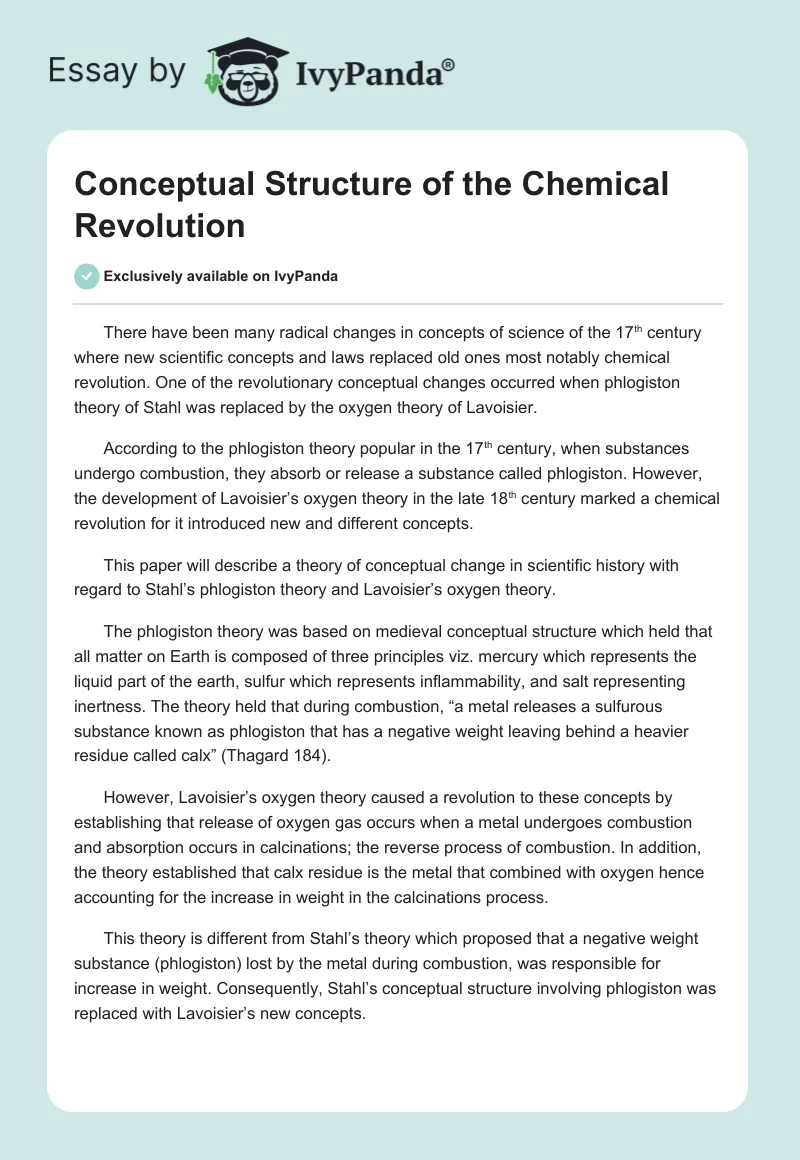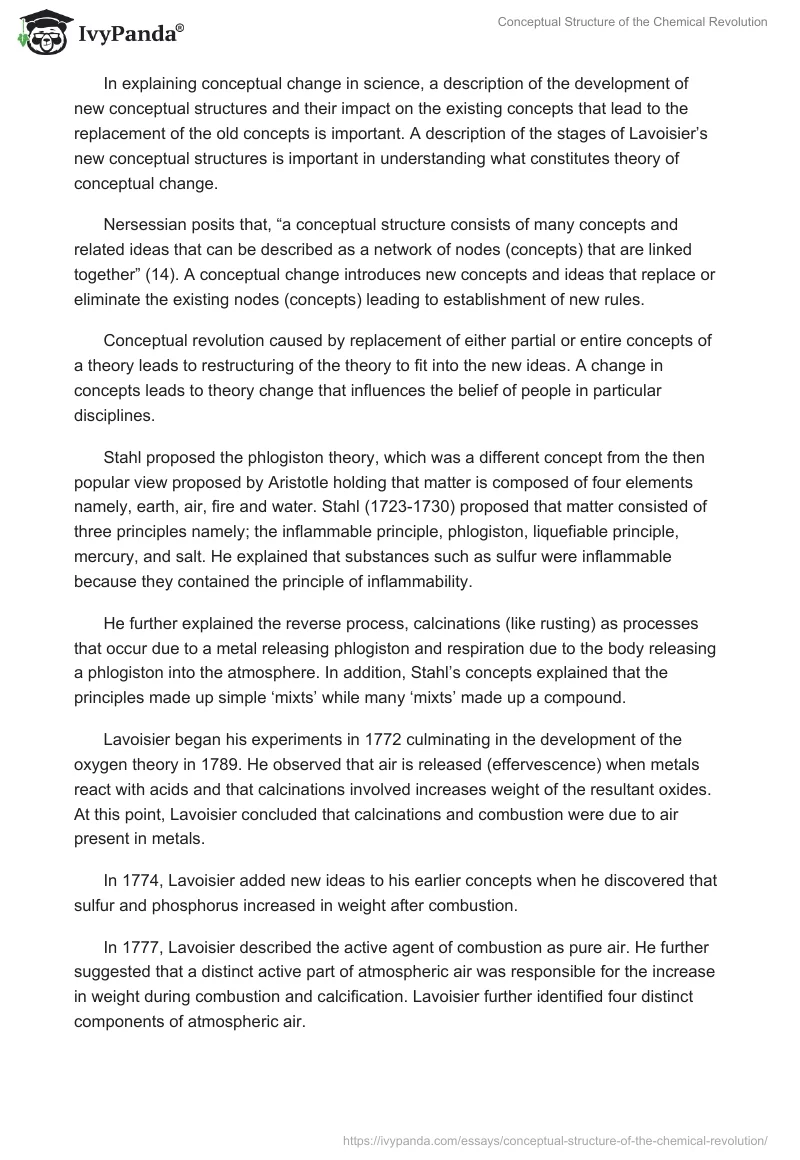There have been many radical changes in concepts of science of the 17th century where new scientific concepts and laws replaced old ones most notably chemical revolution. One of the revolutionary conceptual changes occurred when phlogiston theory of Stahl was replaced by the oxygen theory of Lavoisier.
According to the phlogiston theory popular in the 17th century, when substances undergo combustion, they absorb or release a substance called phlogiston. However, the development of Lavoisier’s oxygen theory in the late 18th century marked a chemical revolution for it introduced new and different concepts.
This paper will describe a theory of conceptual change in scientific history with regard to Stahl’s phlogiston theory and Lavoisier’s oxygen theory.
The phlogiston theory was based on medieval conceptual structure which held that all matter on Earth is composed of three principles viz. mercury which represents the liquid part of the earth, sulfur which represents inflammability, and salt representing inertness. The theory held that during combustion, “a metal releases a sulfurous substance known as phlogiston that has a negative weight leaving behind a heavier residue called calx” (Thagard 184).
However, Lavoisier’s oxygen theory caused a revolution to these concepts by establishing that release of oxygen gas occurs when a metal undergoes combustion and absorption occurs in calcinations; the reverse process of combustion. In addition, the theory established that calx residue is the metal that combined with oxygen hence accounting for the increase in weight in the calcinations process.
This theory is different from Stahl’s theory which proposed that a negative weight substance (phlogiston) lost by the metal during combustion, was responsible for increase in weight. Consequently, Stahl’s conceptual structure involving phlogiston was replaced with Lavoisier’s new concepts.
In explaining conceptual change in science, a description of the development of new conceptual structures and their impact on the existing concepts that lead to the replacement of the old concepts is important. A description of the stages of Lavoisier’s new conceptual structures is important in understanding what constitutes theory of conceptual change.
Nersessian posits that, “a conceptual structure consists of many concepts and related ideas that can be described as a network of nodes (concepts) that are linked together” (14). A conceptual change introduces new concepts and ideas that replace or eliminate the existing nodes (concepts) leading to establishment of new rules.
Conceptual revolution caused by replacement of either partial or entire concepts of a theory leads to restructuring of the theory to fit into the new ideas. A change in concepts leads to theory change that influences the belief of people in particular disciplines.
Stahl proposed the phlogiston theory, which was a different concept from the then popular view proposed by Aristotle holding that matter is composed of four elements namely, earth, air, fire and water. Stahl (1723-1730) proposed that matter consisted of three principles namely; the inflammable principle, phlogiston, liquefiable principle, mercury, and salt. He explained that substances such as sulfur were inflammable because they contained the principle of inflammability.
He further explained the reverse process, calcinations (like rusting) as processes that occur due to a metal releasing phlogiston and respiration due to the body releasing a phlogiston into the atmosphere. In addition, Stahl’s concepts explained that the principles made up simple ‘mixts’ while many ‘mixts’ made up a compound.
Lavoisier began his experiments in 1772 culminating in the development of the oxygen theory in 1789. He observed that air is released (effervescence) when metals react with acids and that calcinations involved increases weight of the resultant oxides. At this point, Lavoisier concluded that calcinations and combustion were due to air present in metals.
In 1774, Lavoisier added new ideas to his earlier concepts when he discovered that sulfur and phosphorus increased in weight after combustion.
In 1777, Lavoisier described the active agent of combustion as pure air. He further suggested that a distinct active part of atmospheric air was responsible for the increase in weight during combustion and calcification. Lavoisier further identified four distinct components of atmospheric air.
At the same period, Scheele, Lavoisier and Priestley were able to isolate pure active ingredient of air responsible for calcinations and combustion. At this point, Lavoisier outlined the weakness of phlogiston theory for failure to isolate the phlogiston that according to Stahl, explained the increase in mass of substances after combustion.
In 1780s, Lavoisier was able to develop the oxygen theory completely overturning the concepts of phlogiston theory. He described the active pure component of air as the ‘principe oxygine’ or oxygen that was responsible for combustion. He also described the heat or fire produced during combustion as ‘caloric’ but noted that air was responsible for the heat produced during combustion rather than the combustible elements proposed by phlogiston theory.
He further noted that metals burnt in oxygen to produce oxides while nonmetals produced heat or light during combustion. Through the continuous and cumulative development of new ideas and concepts, Lavoisier was able to point out the limitations of Stahl’s phlogiston theory and developed the oxygen theory to replace it.
The theory of conceptual change involves a continuous and cumulative development of new concepts that builds on existing ideas and finally culminates into a new theory that replaces the existing one. Lavoisier, in 1772 had remote idea that air is involved during combustion; an idea he developed further with new evidence and innovations to finally give out the oxygen theory in 1783 that disputed the phlogiston theory.
The theory of conceptual change must not only explain the origin of conceptual structures in science, but also explain how they rival the existing concepts. In addition, this theory should also explain the acceptability of the new concepts by the larger scientific community.
Two theories can explain the revolutionary conceptual change in science; the accretion and gestalt theories even though the accretion theory is insufficient as it avoids the cumulative and continuous organization of ideas into a theory.
The accretion theory outlines the build up of new ideas into a new-conceptual organization that replaces the existing ones. The views held by Stahl are contrast those held by Lavoisier.
The phlogiston theory maintains that metals are composed of calxes and phlogistons are released during combustion. On the other hand, the new conceptual scheme by Lavoisier holds that the oxygen and metals make up the calxes (oxides). The conceptual change involved introduction of new concepts and replacement of the old conceptual scheme.
The Gestalt Switch theory proposed by Kuhn in 1970 contends that conceptual change is a paradigm shift from the existing concepts and does not involve the reorganization of ideas that goes into a scientific concept.
However, during the development of the oxygen theory, Lavoisier did not make a paradigm shift in ideas but rather built on his ideas eventually coming up with the oxygen theory, a major contribution to the chemical revolution. An ideal theory for conceptual change entails innovations, scientific discovery, and computational research.
Works Cited
Nersessian, Nancy. “Mental Modeling in Conceptual Change.” The Handbook of Conceptual Change 4.2 (2008): 12-19.
Thagard, Paul. “The Conceptual Structure of Chemical Revolution”. Philosophy of Science 57.2 (1990): 183-209.


